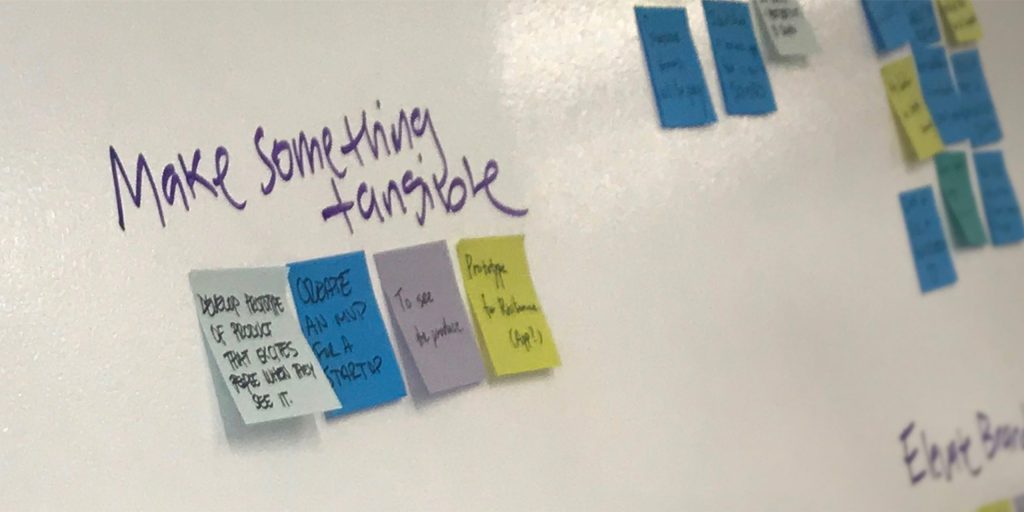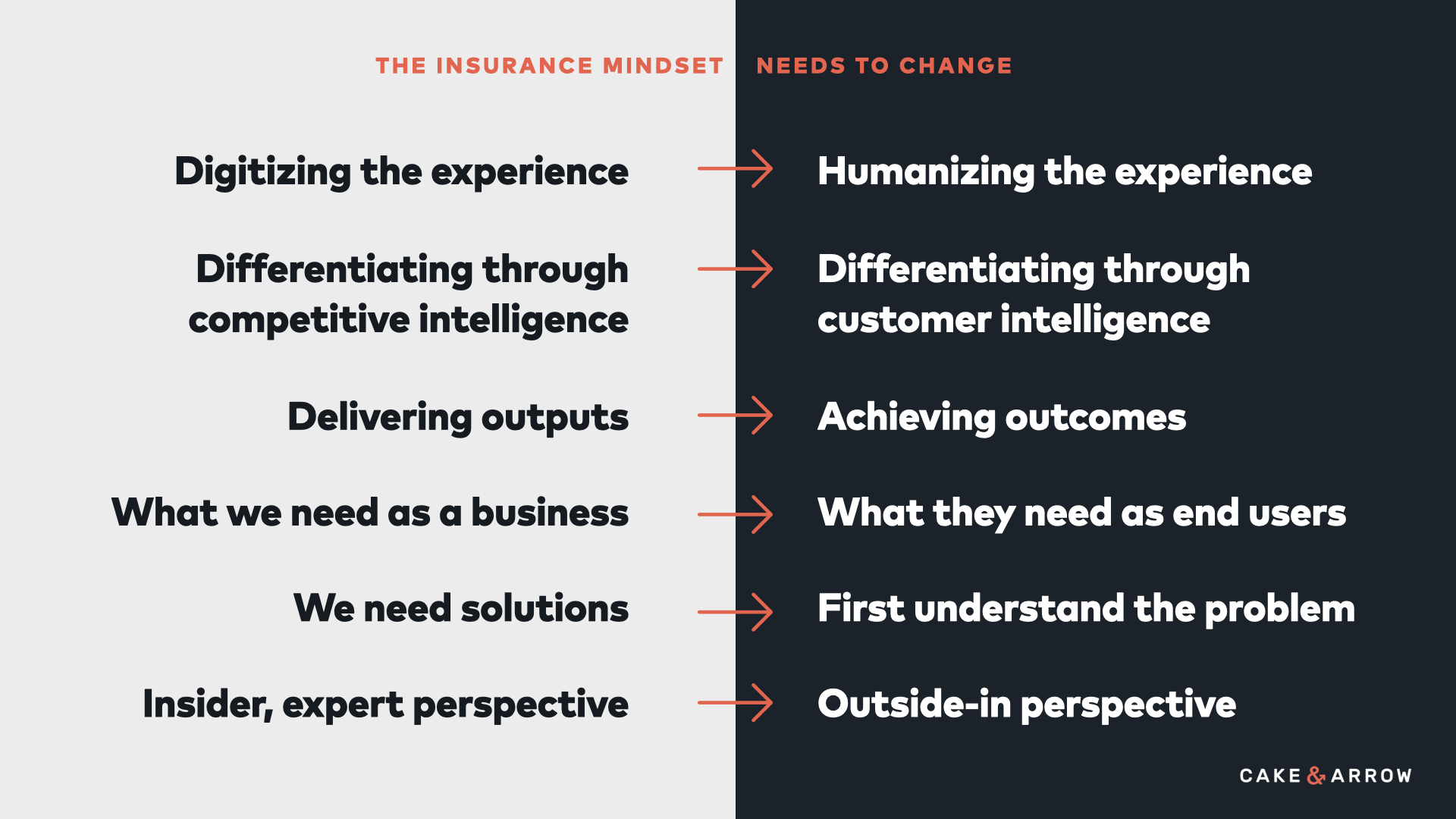The mindset shift the insurance industry doesn’t know it needs

by Josh Levine
Ten years ago, Cake & Arrow pivoted its strategic focus from e-commerce to insurance and financial services. It’s been an incredible journey of discovery, exploration, and experimentation. We’ve seen a lot over that time – 140+ projects with 35 insurance companies across all lines of business. Each engagement has provided intimate access to the business of insurance. We’ve embedded ourselves in the culture of the companies we work with, observing how decisions get made and problems get solved and situated ourselves on the front lines, witnessing first-hand what customers, agents, and employees see, feel, and experience.
Together, these experiences have uniquely positioned us to see the connection (or lack thereof) between what the business is saying and doing with what the customers are longing for and ultimately experiencing.
Perception versus reality
When people think about insurance, many imagine a beleaguered industry unwilling to adapt to new customer expectations and a customer base that doesn’t connect with the promise that insurance has to offer. Our research and experience says otherwise.
We continually see that customers, both young and old, do believe in the value of insurance. On the business side, the industry does want to make meaningful connections with their customers and they want to deliver value beyond fulfilling claims. They’ve just had trouble figuring out how to do this.
Despite high-minded aspirations and mission statements about empowering people’s financial well-being and helping businesses thrive, when insurance companies attempt to act on their transformation initiatives, we see them fail time and time again. Early momentum gets lost, customer-centered initiatives get tabled, and digital experiences — those that see the light of day — are failing to meet customer expectations. So, if the intent is there, why doesn’t it make its way into the end experience?
A mindset shift
“We can’t solve our problems with the same thinking we used when we created them.” – attributed to Albert Einstein
Most would say the floundering is a result of broad, systemic challenges. Bureaucracy, siloed org structures, legacy systems, slow, inefficient processes. The challenge we see, however, is much less discussed; to sustain progress and deliver on experience aspirations, industry leaders need to do more than embrace new technology, they need to embrace and adopt new ways of evaluating, problem-solving, solutioning, and prioritizing. The traditional ways of thinking no longer apply. To connect with a new customer mindset, the insurance industry must embrace a new mindset of its own.
What should this mindset shift look like? It’s not just one grand leap, but a sequence of smaller transformations that will collectively spark the kind of seismic shift the insurance industry so desperately needs. I hope that you can consider these shifts within your organizations—urging yourself, your teams, colleagues, and superiors to think differently to bridge the gap between what your business wants and what your customer needs. It all starts with that shift in mindset. Let’s jump in.
6 mindset shifts needed to deliver differentiating customer experiences in insurance
1. Shift from digitizing the experience to humanizing the experience
E-commerce went through its digital revolution in the late 90s. It suddenly became imperative that retailers bring their businesses online. They launched websites that essentially digitized the brick and mortar buying experience — including basic components like a home page, product pages, and a shopping cart and calling it a day.
The real revolution, however, unfolded in the early aughts, when companies like Amazon began emphasizing customer experience, making customer needs central to every business decision. Those who adapted their models to prioritize customer needs came out on top. Those who did not were left behind. No longer did these companies just need a digital presence, they had to deliver tailored experiences that had a tangible impact on people’s lives.
Sound familiar? Insurance is in the first part of this transformation today. It’s imperative that the industry digitize the traditional way of buying and selling insurance. By integrating customer needs from the outset, insurance can avoid the pitfalls of early retailers and get digitization right the first time. To do so, the industry must first take a step back and think about why people are buying their products in the first place and what’s driving them to do so. This approach ensures that digitization is both efficient and meaningfully improving how people buy and engage with insurance.
2. Shift from competitive intelligence to customer intelligence
Picture this: You’re running a full-day customer experience planning session next week, and you have the option to bring just one of these two reports to share with your team and hopefully inspire productive sessions. The first includes the results from a survey of 100 industry CEOs, the second includes the results from 100 customers. Which report do you bring?
If you choose the latter, then you are in the minority (and good for you!). Most will opt for the CEOs perspective. Why? Because we’re wired to place the utmost value on the business point of view. But this continuous desire to know what the industry deems an emerging trend or the latest technology to invest in won’t move us forward—it will only breed more of the same.
Business insights tell you where you are, but customer insights tell you where you need to go. And to deliver meaningful value to customers, you first need to know what it is they value.
While the insurance industry understands the need for ongoing business and competitive intelligence, it’s vital to recognize that customer expectations and behaviors are evolving at a pace parallel to business trends.In fact, these shifting customer expectations are what drive these emerging tech trends. Infusing your business with a balance of competitive and customer intelligence will enable you to focus on the trends that matter, and adapt them based on what your customer needs, rather than what the industry thinks they need.
3. Shift from delivering outputs to achieving outcomes
Having worked across many project teams in insurance, we’ve observed how the industry often measures progress by the sheer volume of features it rolls out, with little focus on the outcomes these features generate.
When outputs are used as a primary metric for progress, essential things like user feedback and UI improvements get thrown off the roadmap and into the backlog, only to be revisited 18 months later—or never. Many months are spent executing work that no longer meets user needs and thus the gap between strategy and delivery widens.
When you lead by outputs, you’re managing the team by telling them what to make. The problem with this is, features don’t guarantee value. When you lead by outcomes, you’re asking the team to drive a specific customer behavior that in turn drives business results. This enables them to find the right solution while remaining focused on delivering value.
An outcome-based approach requires leaders to set a vision and target metrics. By prioritizing outcomes rather than dictating projects, they enable digital teams to adapt and pivot in service of achieving the defined metrics required to compete and differentiate.
A feedback loop informs pivots, essentially de-risking executions and dramatically increasing the likelihood of putting something in the market that fills an actual need and generates business results. In the end, customers don’t place value on how many features you give them. All that matters is the tangible value they see, feel, and experience when they purchase or interact with your product or service.
4. Shift from what “we need as a business” to “what they need as end users”
“The purpose of a business is to create and keep a customer.” — Peter Drucker
Historically, the insurance industry has been business-centric, expecting customers to conform. The customer-centric perspective flips this on its head, requiring the business to meet their customer where they are at, rather than where insurance thinks they should be.
As a business-centric industry, the industry’s focus has been on what it needs from its customers‚—for them to understand insurance, how it works, and the complexities involved. Customer-centricity demands that insurance finds ways to take the complexity off the customer.
Until recently, little consideration was given to the customer perspective at all. Only in the last decade or so has insurance even started talking about customer centricity and only now are we starting to see the industry make real strides toward executing on their CX strategies. The rise of embedded insurance and ecosystem approaches speak to this transformation. Implementing an ecosystem strategy, for example, requires insurance companies to transcend their business sector and evaluate the relevance of their products in the context of customer behavior. And as we’ve noted elsewhere, there is no embedded insurance without a deep understanding of the customer lifecycle.
This is a change in perspective that will ultimately lead to a more fundamental operational shift from serving business interests to aligning with customer needs. When done right, insurance transcends the transactional to become an integral component of people’s lives.
5. Shift from “we need a solution” to “let’s first understand the problem”
As humans, we’re hardwired to solve problems. We jump right into solution mode and start talking next steps. Approaching problems this way can rapidly snowball into a resource and budget intensive project spanning years.
While today’s advanced technology, insurtechs, and platforms constantly present exciting opportunities, it’s essential to resist the immediate pull towards solutions. The cost of not doing so can be high. Many insurers can recount stories of releasing a digital experience after years of development, only to see that people don’t use it or performance dips. Why? Because it wasn’t solving a real problem or fulfilling a real human need. The best solutions tackle real, human pain points. To discern these, it’s vital to deeply understand of people’s behaviors, fears, and aspirations.
So how do we do this? It starts by asking the right questions. From what we’ve observed, the insurance industry typically asks solution-oriented questions instead of problem-oriented questions. For example. Imagine your agent portal needs a redesign. The industry default might be to start by simply asking “What feature or functionality is missing?” or “What do you want us to change?” This is just solutioning masquerading as research. When you do things this way, your solutions fail to get at the agent’s actual problem or what they are trying to achieve with your tool. Instead, ask open-ended questions like… “How do you gauge an insurer’s appetite for risk? and “Can you walk me through your workflow for getting a client from quote to bind?”
Asking questions like these will help you better understand their process and pain points, and ultimately lead to better solutions that truly address the human need.
For those entrenched in the insurance industry, disentangling solutions from problems can be challenging. Decoupling these elements requires structured methods to help you grasp your stakeholders’ objectives, priorities, capabilities, and desired outcomes.
6. Shift from an insider, expert POV to embracing the outsider perspective
“In the beginner’s mind there are many possibilities, but in the expert’s there are few.” — Shunryu Suzuki
Perhaps because of its complexity and long history, the insurance industry has a deep reverence for expertise—insurance expertise. It has evolved accordingly, becoming notoriously insular, not only hiring from within but looking inward—at what its own leaders and companies are doing and saying—as it shapes its strategic vision. While there is certainly a time and a place for expertise, relying on it exclusively can, as we’ve seen in insurance, stifle fresh perspectives and inhibit true transformation.
The idea of the beginner’s mind, which fosters an attitude of openness, curiosity, and a willingness to question assumptions, is found not only in young people but in industry outsiders—people working in companies and industries outside of insurance, such as real estate, ecommerce, medicine. It’s found in design agencies like Cake & Arrow, which bring a designer’s mind (not unlike a beginner’s mind) to bear on insurance industry problems. I believe that the insurance industry needs more outsiders. They need them not as a replacement for internal expertise, but as a complement to it.
So how do you bring outsiders in? It starts with breaking down the mental barriers. Invite your teams to bring in ideas from other industries. Shoot down the myth that this industry is uniquely unique with its own unique challenges. Get creative. Get out of your comfort zone. And as with any move toward diversity, make it an intentional and targeted effort. Recruit from other industries and put aside the idea that “no one wants to work in insurance.”
Embracing and cultivating an outsider mindset, with its inherent openness and curiosity, will not only open the door to fresh perspectives but will help you better leverage your own expertise.
Turning the ship
Throughout my 10 years as an “outsider” deeply immersed in the business of insurance, I’ve noticed a growing awareness of what I’ve identified as a disparity between the industry’s own aspirations and the reality of its customer experience. And I’ve seen the industry make significant progress toward closing this gap. But the transformation is far from complete and the industry itself is the only thing getting in the way. Doing the painstaking work to shift mindsets is challenging but also exciting—and dare I say—fun. Focusing on the incremental shifts, each one unlocking potential and narrowing the gap between ambition and execution, is the only way to turn the behemoth of a ship that is insurance in the right direction.
This article was adapted from an earlier presentation delivered by Josh Levine entitled, Adopting a new mindset to deliver differentiating employee and customer experiences. You can download the presentation here.


